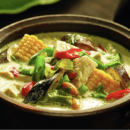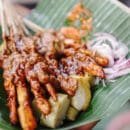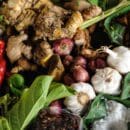HOUSEWIFE ROAST – RIJSTTAFEL
Friday August 10, 2024
Dutch-Indonesian Rijsttafel: Selamat Makan!

BOOKING
Reservations Closed

RIJSTTAFEL
The Dutch-Indonesian rijsttafel (rice table) is a traditional combination of dishes from various Indonesian food cultures. It consists of a number of perfectly harmonised dishes. All main and side-dishes are put on the table at the same time. Everyone composes his own menu from them. It is not only about the eating itself; socialising and togetherness are equally important. It is a traditional element of festive occasions like annual events, reunions, memorials and other gatherings. The recipes for the rice table are often family recipes from the former Dutch East Indies, passed on by granny, aunty or 'kokkie' (the cook).
- vegetarian
- vegan
- plant-based
- gluten free
- lactose free
- raw

SAYUR LODEH
This dish means “vegetables cooked in coconut milk”. It has Indonesian origins from Java. Vegetables such as bamboo shoots, baby corn, sweet potato, and Thai eggplants are served with kaffir lime leaves and a light coconut broth.
- Soup
- vegetarian
- vegan
- plant-based
- gluten free
- lactose free

TUMIS TEMPE TAHU
Tofu, bean sprouts and kecap pedis.
- vegetarian
- vegan
- plant-based
- gluten free
- lactose free

SAMBAL GORENG TERONG BALADO
Roasted aubergine in a spicy tomato sauce.
- vegetarian
- vegan
- plant-based
- gluten free
- lactose free

GADO GADO
A hearty dish, which has its roots in Indonesia (in Indonesian it literally means "mix-mix"), Java, Sudan, and also Suriname. Our version comes with fried tofu, crunchy vegetables, and a lovely spicy peanut dressing. You can have your course with or without egg.
- vegetarian
- vegan
- plant-based
- gluten free
- lactose free

SATÉ AYAM
Skewered chicken with a sultry peanut sauce.
- (Option 1)
- gluten free
- lactose free

GULAI NANKA
Our delicious jackfruit coconut curry with long beans and fragrant lemongrass (instead of the chicken satay).
- (Option 2)
- vegetarian
- vegan
- plant-based
- gluten free
- lactose free

NASI KUNING
The most important element of a rijsttafel is of course rice. In our case Indonesian yellow rice. This cone shaped rice is to represent the mountains and clearly the focal point of the meal. It is flavored with coconut milk and gets its beautiful hue from turmeric.
- vegetarian
- vegan
- plant-based
- lactose free
- gluten free

ATJAR KETIMUN
Pickled sweet and sour cucumber and shallots with a hint of chili.
- vegetarian
- vegan
- plant-based
- gluten free
- lactose free

SERUNDENG
Roasted and shredded coconut.
- vegetarian
- vegan
- plant-based
- gluten free
- lactose free

PISANG GORENG
Crispy banana fritters. The ultimate comfort food!
- vegetarian
- vegan
- plant-based
- gluten free
- lactose free

KROEPOEK
Cassave crackers.
- vegetarian
- vegan
- plant-based
- gluten free
- lactose free

SPEKKOEK
A Dutch-Indonesian spice cake, also called Thousand Layer Cake in English.
- Dessert
- gluten free
- lactose free
- vegetarian

Historical Background
In the late 1500s, Dutch traders ventured to the Indonesian islands of Maluku and returned with spices like cloves, mace, and nutmeg. These expeditions were so lucrative, the islands were deemed "The Spice Islands," and by the early 1600s, the Dutch East India Company (VOC) established a trading post on Java, Indonesia. The Dutch government granted the VOC semi-governmental powers and resources. By the end of the 1600s, the VOC controlled the region, deemed the Dutch East Indies, through force. Dutch colonizers embraced Indonesian cuisine and used the diversity of dishes to impress visiting nobles and merchants. Heaps of steaming rice would be laid on a table alongside dishes from all throughout the archipelago, creating an indulgent meal called rijsttafel, or "rice table." Dutch colonization expanded to the Caribbean throughout the 1600s, notably on the islands of Sint Maarten, Bonaire, Sint Eustatius, Curaçao, Saba, and Aruba (today's Dutch Caribbean). Other Caribbean islands like Saint Croix, Tobago, Tortola, Saint Thomas, and Anegada also had a Dutch presence during this time through the Dutch West India Company (WIC). In the early 17th century, Indonesian spices and recipes arrived on the shores of the Caribbean, where they can be savored in even more unique ways today. Though the Caribbean and Indonesian archipelagos are over 27.000 kilometers apart, they've been linked through a shared history of Dutch colonization and occupation. Dutch adoption of Indonesian cuisine and the Indonesian diaspora are why you can find authentic Indonesian fare in the heart of the Caribbean, often blended with other flavor combinations and cooking techniques from other European territories.
NATURAL WINE

HOUSEWIFE PAIRINGS
As always, the menu is paired with remarkable natural wine from women producers.
- natural wine
